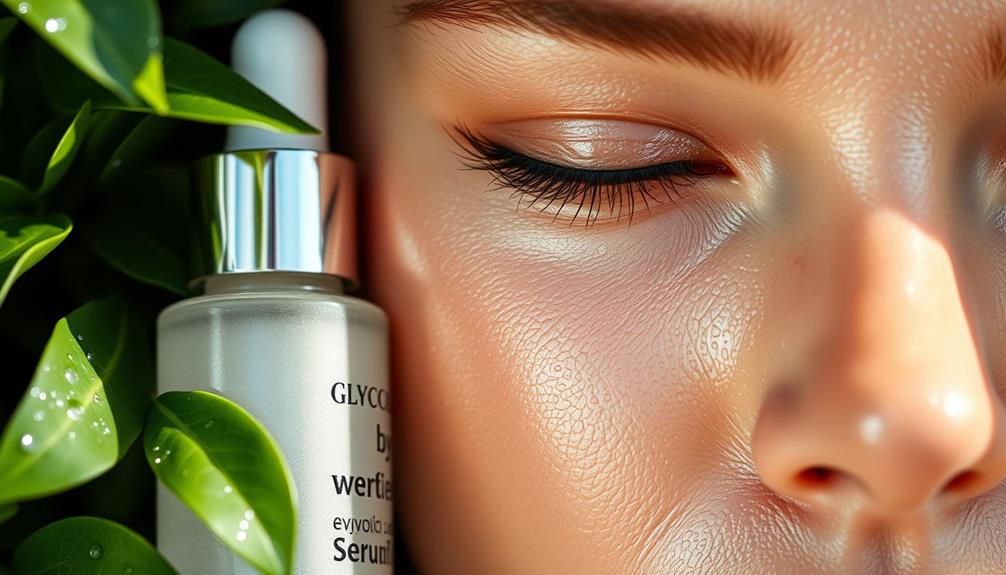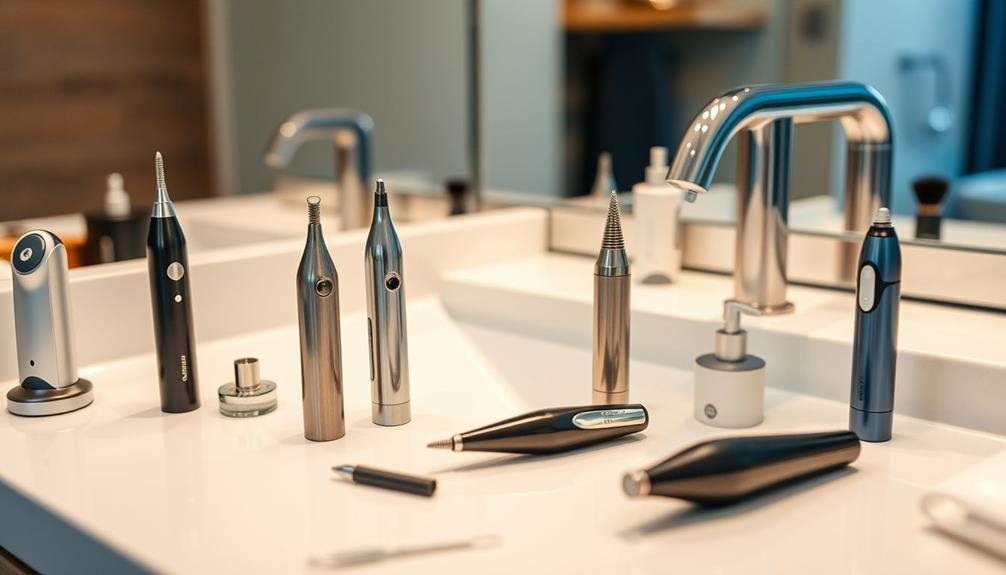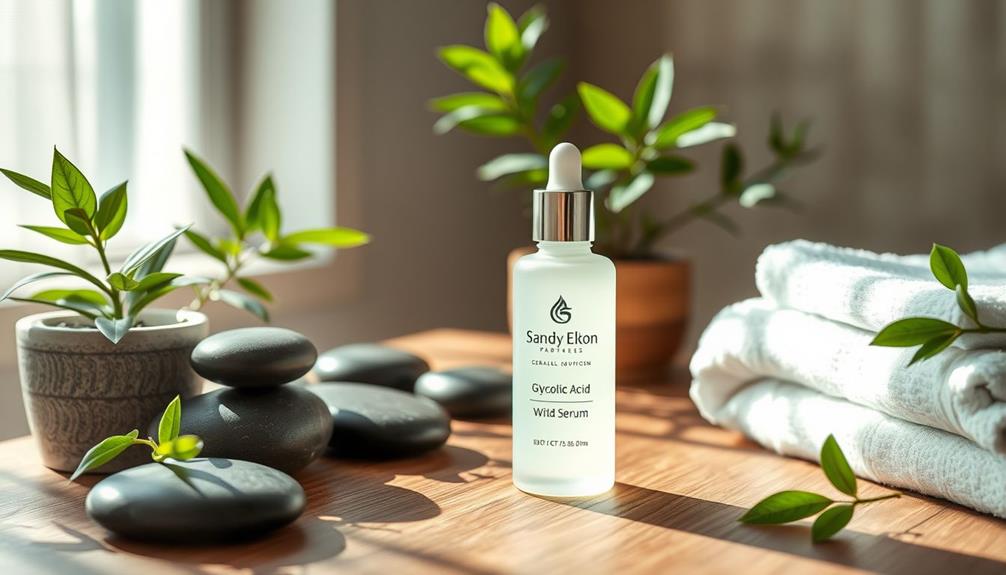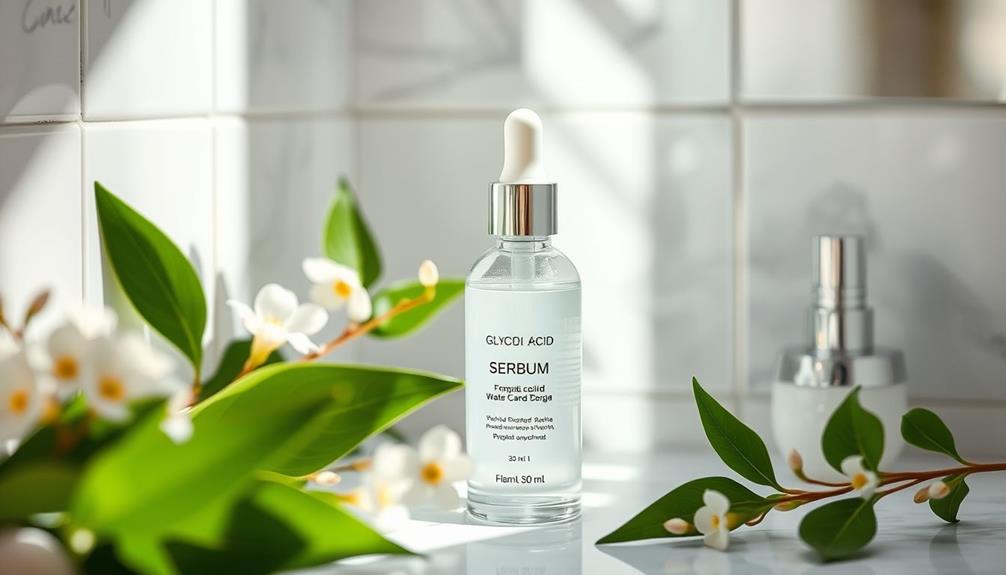Glycolic acid's an incredible ingredient for your skin that offers a host of benefits. It exfoliates gently, promoting smoother skin texture and reducing fine lines. If you're battling acne, it unclogs pores and helps diminish post-acne scars. Plus, it stimulates collagen production, enhancing skin elasticity and firmness, which is perfect for anti-aging. Regular use can brighten your complexion and restore radiance. Just remember to start with a low concentration and use sunscreen daily since it can increase sun sensitivity. To discover even more about how to integrate glycolic acid into your routine, stick around for more insights!
Key Takeaways
- Glycolic acid effectively exfoliates the skin, promoting smoother texture and reducing fine lines and rough patches.
- It treats acne by unclogging pores and enhancing the effectiveness of other acne treatments.
- Regular use stimulates collagen production, improving skin elasticity and combating signs of aging.
- Glycolic acid brightens the complexion, leading to a clearer, more radiant skin appearance.
What Is Glycolic Acid?
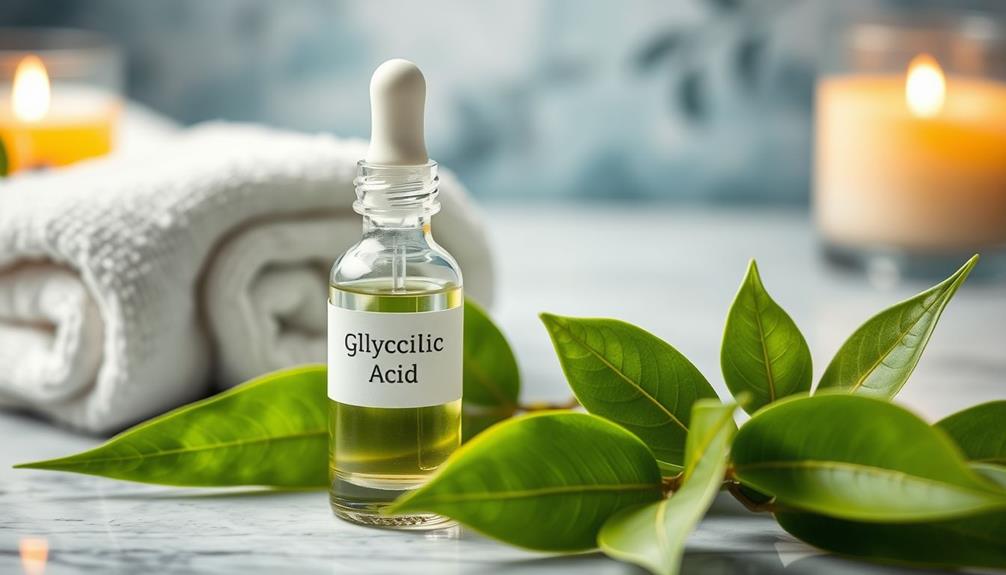
Glycolic acid is an alpha hydroxy acid (AHA) derived from sugarcane, known for its powerful exfoliating properties that help refresh and rejuvenate your skin. As the smallest molecular size among AHAs, glycolic acid penetrates deeply, effectively promoting cell turnover and enhancing your skin texture. By breaking down the bonds between dead skin cells, it allows for a smoother, clearer complexion. Additionally, incorporating essential oils for skin health can further boost your skincare routine, providing hydration and nourishment.
Incorporating glycolic acid into your skincare products—like cleansers, toners, serums, and chemical peels—can considerably improve various skin concerns. It's particularly effective in addressing issues like acne, sun damage, and signs of aging by stimulating collagen production. This boost in collagen not only improves skin firmness but also contributes to an overall youthful appearance.
However, keep in mind that glycolic acid can make your skin more sensitive to UV rays. This means that when you include it in your routine, using sunscreen becomes essential to protect against sun damage. By understanding what glycolic acid is and how it works, you can better appreciate its role in achieving healthier, radiant skin.
Key Benefits for Skin

When you use glycolic acid, you'll notice its powerful exfoliation benefits that lead to a smoother skin texture.
This ingredient not only helps treat acne effectively but also offers impressive anti-aging properties, similar to how a vibrant diet rich in colors can enhance your overall skin health.
With regular use, you can enjoy a brighter, clearer complexion that feels youthful and refreshed.
Exfoliation and Smoother Texture
Exfoliating with glycolic acid can transform your skin's texture, revealing a smoother and more radiant complexion. This powerful ingredient works by penetrating deeply into the skin, effectively dissolving the bonds between dead skin cells.
By promoting exfoliation, glycolic acid helps remove dead skin cells, enhancing skin texture and allowing fresher skin to shine through. Additionally, integrating essential oils like lavender or tea tree oil into your skincare routine can complement the effects of glycolic acid, promoting relaxation and providing natural antibacterial properties for clearer skin essential oils for skin health.
Regular use of glycolic acid can greatly improve your skin's overall appearance. As it increases cellular turnover, you'll notice a refined appearance with reduced rough patches and a reduction in fine lines. Clinical studies back this up, showing visible results after just a few applications.
You can achieve a smoother complexion and diminished enlarged pores, making your skin look healthier and more youthful. Incorporating glycolic acid into your skincare routine is a smart move if you're looking to enhance your skin texture.
Not only does it help in removing old skin cells, but it also encourages the growth of new ones, leading to a revitalized and vibrant look. Embrace glycolic acid for a glowing, smoother skin texture that you'll love to show off.
Acne Treatment Effectiveness
Unclogging pores and reducing acne lesions are just a couple of the key benefits that make glycolic acid a powerful ally in your skincare routine. This ingredient effectively dissolves dead skin cells, helping to prevent the formation of new acne.
In clinical studies, even concentrations as low as 5% glycolic acid have shown significant improvements in mild to moderate acne for individuals aged 12 and older. Furthermore, incorporating glycolic acid into your regimen can also complement other treatments, much like how eye patches can aid in improving vision by occluding one eye.
Its exfoliating properties not only enhance skin texture but also boost the effectiveness of other acne treatments. By allowing topical medications to penetrate deeper, glycolic acid can lead to more effective acne treatment. Additionally, its antibacterial properties help inhibit the growth of acne-causing bacteria, further promoting a clear complexion.
Regular use of glycolic acid can also help diminish the appearance of post-acne scars, making your skin look smoother and more even.
Anti-Aging Properties
While tackling acne is important, glycolic acid also shines in its ability to combat the visible signs of aging, making it a versatile addition to your skincare routine. Its remarkable anti-aging properties can help you achieve a more youthful complexion and improved skin texture.
Here are some key benefits of incorporating glycolic acid into your regimen:
- Stimulates collagen production: Enhances skin elasticity and firmness, effectively reducing fine lines and wrinkles.
- Increases cell turnover: Promotes the growth of new skin cells, helping to rejuvenate photo-aged skin.
- Exfoliates dead skin: Smooths the skin's surface for a polished appearance, combating signs of aging.
With regular use, glycolic acid not only helps to improve skin texture but also guarantees your skin feels more hydrated and revitalized.
How to Use Glycolic Acid
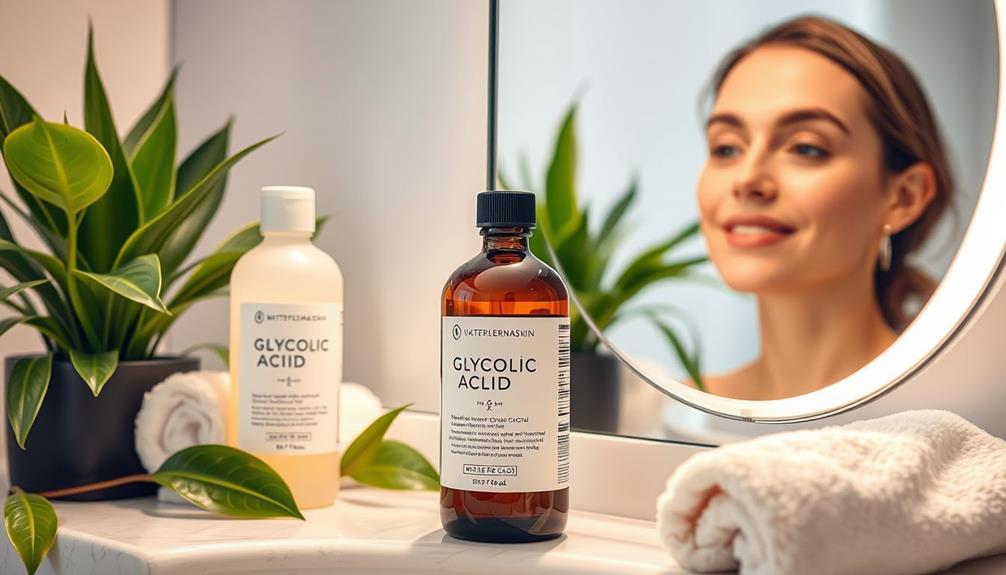
To effectively use glycolic acid, start with a low concentration product and gradually increase your usage to help your skin adjust.
Begin with a product around 5% and aim to apply glycolic acid once daily, ideally at night. For cleansers, use only a pea-sized amount and rinse. If you're using toners, serums, or creams, apply a few drops or a pea-sized amount to clean, dry skin.
It's essential to conduct a patch test on a small area first, especially if you have skin sensitivity. This way, you can check for any adverse reactions before full application. As you incorporate glycolic acid into your routine, monitor the frequency of use to avoid skin irritation.
To maximize its benefits, remember that glycolic acid helps exfoliate skin and boosts collagen production, promoting a more youthful appearance.
However, since it can increase your skin's sensitivity to UV rays, always follow up with broad-spectrum sunscreen of at least SPF 30 during the day. Also, avoid using glycolic acid with other potent active ingredients on the same day to minimize the risk of irritation.
Potential Side Effects

While glycolic acid offers great benefits, it's important to be aware of potential side effects.
You might experience skin irritation, such as redness or itching, especially if you have sensitive skin.
Additionally, heightened sun sensitivity can put you at risk, so always remember to apply sunscreen when using this ingredient.
Skin Irritation Risks
Using glycolic acid can lead to skin irritation, with symptoms like redness, itching, and burning sensations often affecting sensitive skin types. While glycolic acid has incredible benefits, it's essential to be aware of potential adverse effects, especially if you're new to it or have sensitive skin.
Here are some important considerations to keep in mind:
- Start with a lower concentration: If you're new to glycolic acid, begin with a concentration below 10% to minimize irritation.
- Conduct a patch test: Always perform a patch test before applying products to larger areas. This helps identify any potential reactions.
- Monitor your skin's response: Pay attention to any signs of irritation. If you notice excessive redness or discomfort, it might be time to reduce usage.
Sun Sensitivity Concerns
Glycolic acid can make your skin more sensitive to UV rays, increasing the risk of sunburn and long-term skin damage. This heightened skin sensitivity is particularly concerning for those who've lighter skin types or have recently undergone chemical peels.
If you're using glycolic acid, it's vital to apply a broad-spectrum sunscreen with at least SPF 30 daily to protect your skin. Without proper sun protection, you may experience adverse effects like hypopigmentation, especially if you have darker skin tones. Increased melanin production triggered by UV exposure can lead to uneven skin tone and dark spots.
To minimize these risks, consider using glycolic acid products primarily at night and always reapply sunscreen every two hours while outdoors.
Consulting a dermatologist is a smart move for tailored advice on how to effectively incorporate glycolic acid into your skincare routine while ensuring adequate sun protection.
Balancing the benefits of exfoliation with the need for skin safety is essential. By taking the right precautions, you can enjoy the amazing benefits of glycolic acid without compromising your skin's health.
Safety and Precautions

To guarantee your safety when incorporating glycolic acid into your skincare routine, always start with a patch test on a small area of skin. This will help you check for any potential allergic reactions or skin irritation before applying it to your entire face.
If you have sensitive skin or conditions like eczema, consult a dermatologist to verify it's safe for you.
Here are some important safety tips to remember:
- Begin with lower concentrations of glycolic acid to minimize skin sensitivity.
- Gradually incorporate glycolic acid into your routine, increasing frequency as your skin adjusts.
- Always apply a broad-spectrum sunscreen with at least SPF 30 during the day, as glycolic acid can heighten your skin's sensitivity to UV rays.
Choosing the Right Products
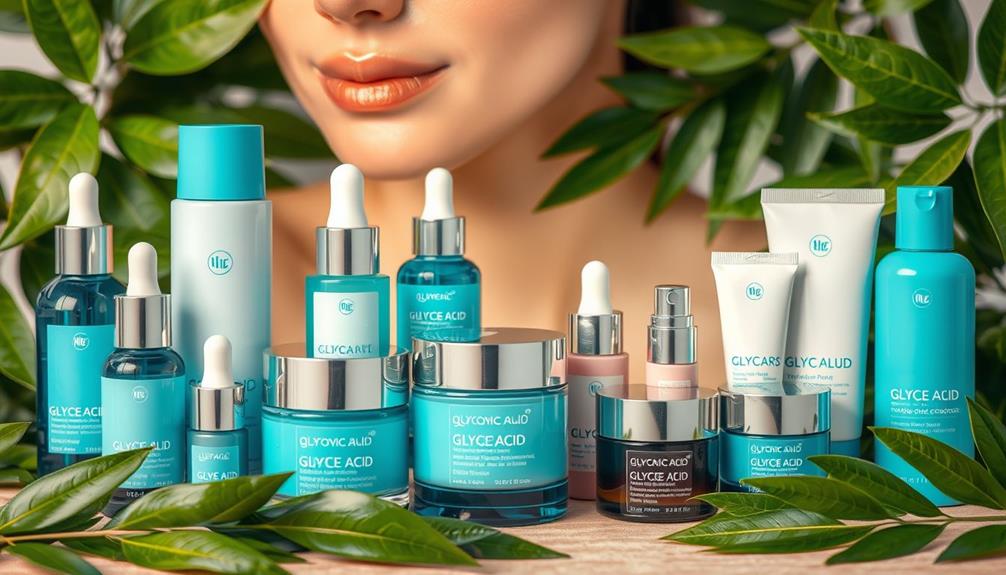
Finding the right glycolic acid products can considerably enhance your skincare routine while minimizing the risk of irritation.
Start by selecting formulations with a concentration of 5% to 10%, especially if you're a beginner. This range balances efficacy and sensitivity, vital for those with sensitive skin.
It's also essential to check the product's pH; aim for around 4, as this enhances the exfoliating effects of glycolic acid.
When it comes to product format, opt for leave-on products like serums and creams, which typically deliver better results than wash-off cleansers.
Before applying glycolic acid to your face, always conduct a patch test on a small area of your skin. This step helps you gauge your skin's tolerance and avoid any adverse reactions.
If you're unsure which product suits your skin type and concerns best, consulting a dermatologist can provide personalized guidance. They can recommend effective glycolic acid products that align with your skincare goals while ensuring safe usage.
With the right choices, you can enjoy the remarkable benefits of glycolic acid without compromising your skin's health.
Conclusion
Incorporating glycolic acid into your skincare routine can be like revealing a treasure chest of benefits for your skin.
Its ability to exfoliate, brighten, and rejuvenate makes it a must-have.
Just remember to start slow and pay attention to your skin's needs.
With the right product, you'll be on your way to a glowing complexion that turns heads.
Embrace the power of glycolic acid and watch your skin transform into the radiant canvas you've always wanted!
